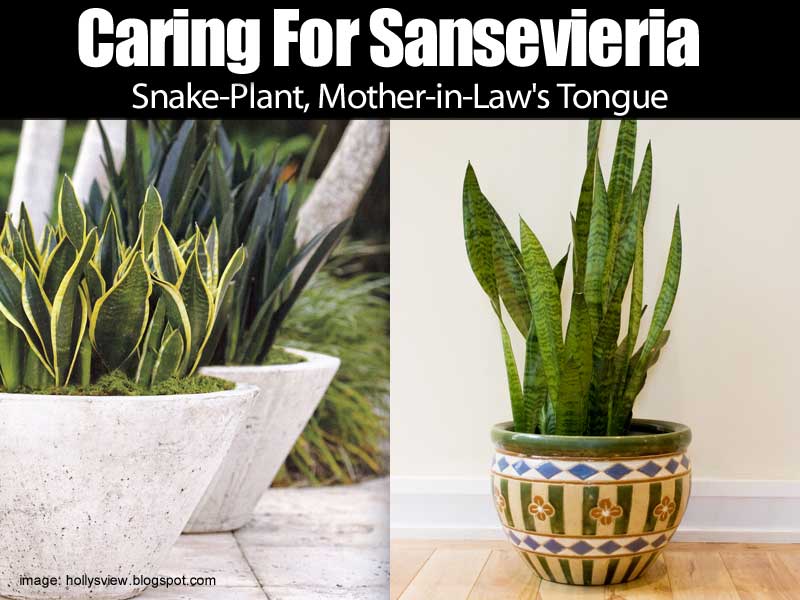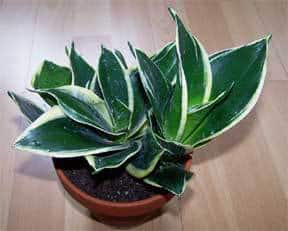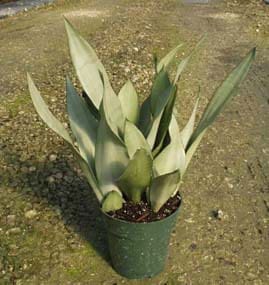The snake plant or Sansevieria pronounced (san-se-vi-ee’-ri-ah) a member of the Lily Family, popularly goes by other common names. The very “politically correct” Mother-in-Law’s tongue and Bowstring-hemp.
The genus named after the Prince of Sansevero born in Naples in 1710. The primary plant of the genus Sansevieria trifasciata, originates from tropical Africa. The snake plant has been in cultivation for over 250 years. But grown in the US foliage trade since the 1920’s.
Sansevieria tops the list as being the most tolerant of all decorative plants to survive the most unsuitable growing conditions, abuse and neglect a plant could receive. Basically, you have to work really hard to kill sansevieria.

The snake plant makes and excellent potted plant indoors as a houseplant or outdoors.
The leaves, generally stiff, very thick, spearlike, glossy texture, often mottled with white, and clustered flowers on slender stalks.
Types Of Sansevieria
Snake plants come in basically two types:
The well-known tall ones – sansevieria trifasciata, laurentii and zeylanica of which you’ll find several forms and the squashed-down types known as-birds-nest. Whoever gave them that name, I don’t know, at least it’s a catchy common name.
The genus boast about 60 varieties but roughly 15 varieties find themselves grown commercially.
Sansevieria trifasciata a bold stiff plant with dark green leaves. The variety Laurenti with leaves banded in light yellow-green, and a bit showier.

The bird nest type, usually Sansevieria Hahnii, a dense rosette of dark green leaves with gray-green crossbands, and its relative, Sansevieria golden Hahnii, having two or three broad bands of yellow and several longitudinal yellow stripes.
These bird nest snake plants make choice “dish-garden” and terrarium plants, not only due to their compact shape but also because of their durability.
Check out the Bird Nest Type Snake Plant in the video below
Potting & Repotting The Mother In Law’s Tongue
Divide plants at any time during the year, however, spring is the best.
Remove the plant from of the pot. Using a knife or sharp clippers cut it up as much as you want. Plant each piece in a container with a well draining soil like this.
The plants grow actively during the summer, dividing in spring will produce the quickest results. Each division will soon grow and produce a nice plant.
Snake plants do well in a good potting soil as they are not very demanding. Sansevierias are very “succulent“; “heavy plants” which hold lots of water in their leaves. It is often recommended to create a “heavy soil” by amending the potting mix with some sand.
How Often Should You Water Sansevieria?
Be cautious when watering, especially during the winter, better to err on the dry side. Watering is usually a matter of personal judgment. I water my snake plants whenever they seem to need it, about every 2-3 weeks. Few plants should be kept constantly wet, fewer should ever be allowed to suffer from lack of moisture.
Sansevieria – One Tough Houseplant

Plants as with fashion seem to come and go and come back again. Over the last few years Sansevieria started to make somewhat of a comeback.
These plants make great houseplants due to their versatility in both size and growing conditions.
You’ll find Sansevieria used in small dish gardens all the way up into 14″ containers 42″ inches in height. They handle full sun, look great on a patio during the spring and summer, but also can go inside into very low light.
This plant can hang with the best of all low light plants.
Temperatures below 45 degrees for extended periods is one climatic condition it will not tolerate. When the plants become damaged it can show up slowly over a 1- 4 week period.

One Sansevieria Downside
Everything seems to have a downside and the Sansevieria is no different. Their downside, weight.
Because of their relationship to the succulent family they hold a lot of water.
As plants reach 10″ and larger in pot size the weight goes up dramatically. I’ve seen 10″ plants that weight 25 pounds or more.
If You Want A Houseplant That:
- Is tough indoors
- Can be placed just about anywhere
- Takes up little space
- Goes a long time between watering
- A good starter plant for the house
- Can start outside in spring and move inside
- Has no real pest problems
Take a look at the Sansevieria.
Propagation – Dividing & Leaf Cuttings
In south Florida, stock plants grow in beds out in full sun. One very unusual production method of these plants; growers actually mow down the tops of the plants forcing them to produce new growth.
Sansevierias propagate easily by division; since most varieties sucker freely, this is usually the preferred method of propagation. Snake plants propagate from leaf cuttings, clumps or rhizome cuttings.
Propagate by cutting the leaves by cutting leaves into three-inch lengths, and inserting the lower third of these in damp sand. With this method, however, the yellow banding or marginal stripes may be lost, with the new plants reverting to type.
Sansevieria Cylindrica – The Popular Oddball

One odd sort you may discover when searching for a “different” or rare sansevieria species is Sansevieria cylindrical. The plant has dark green leaves marked with faint light green bands.
The difference? The leaves are cylindrical instead of being flat or concave. This somewhat fan shape plant is also found in Sansevieria Ehrenbergi, a much more colorful plant with red and white pencil stripes on the upper margins of its bluish leaves.
Another unusual type I’ve become mildly fond of is Sansevieria arborescens, a sort of tree-like plant wholly unlike the customary stemless varieties. This, by the way, has white edges on dull green leaves.
Uses of Sansevieria
The durability of Sansevieria makes it an excellent choice for apartment dwellers who often have limited success with houseplants due to lighting issues. They should take a good look the snake plant.

Admittedly snake plants are not most very graceful plant. The compact birds nest species Sansevieria Hahni are more interesting in their smaller size and also tolerant of dry hot rooms and poor light.
An attractive pottery container greatly enhances the appearance of these plants.
Keep leaves clean and free from dust and grease. Other care consists of keeping the plants moist but not wet, and feeding occasionally.
Sansevieria Hahni with short leaves arranged in a rosette. Hahni makes and excellent low plant for use on a coffee table where little light may be available.
Does Sansevieria Bloom or Flower?
Primarily used as foliage plants but when conditions suit them Sansevierias will burst suddenly and unexpectedly into glorious bloom. The psychological reaction for most sansevieria-owners, is comparable to finding a peacock on their front lawn!
A friend describes the plants as “inelegant” either never saw one in bloom or else needs new glasses.
Granted, individually the flowers do not look like much, but borne in racemes on tall, foot long, stout scapes, making a lovely display. The blossoms usually white or cream, sometimes greenish (those of Sansevieria cylindrica have a pinkish color), are often fragrant.